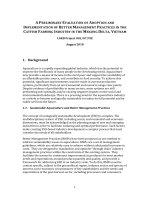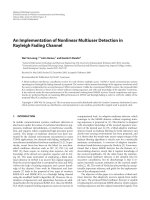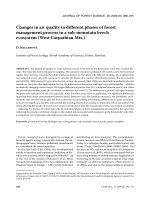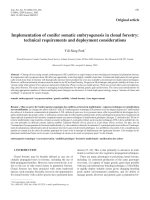IMPLEMENTATION OF OPERATIONS MANAGEMENT PROCESS IN SELECTION ORGANIZATION
Bạn đang xem bản rút gọn của tài liệu. Xem và tải ngay bản đầy đủ của tài liệu tại đây (7.46 MB, 84 trang )
<span class="text_page_counter">Trang 1</span><div class="page_container" data-page="1">
Student’s signature:
</div><span class="text_page_counter">Trang 2</span><div class="page_container" data-page="2">1
</div><span class="text_page_counter">Trang 3</span><div class="page_container" data-page="3">erifier’s
</div><span class="text_page_counter">Trang 15</span><div class="page_container" data-page="15">Table of Co
I. INTRODUCTION ... 7
II. KEY CONCEPTS OF OPERATION MANAGEMENT ... 9
III. IMPLEMENTATION OF OPERATIONS MANAGEMENT PROCESS IN SELECTION ORGANIZATION ... 11
1. General Operation Process ... 11
2. Key Approaches to Operation Management ...13
<small>2.1. Six Sigma ... 13 </small>
<small>2.2. Lean Principle ... 16 </small>
<small>2.3. Difference between Six Sigma and Lean Principle ... 21 </small>
IV. CONTINUOUS IMPROVEMENT PLAN ... 23
1. The Operational Process and Operation Management in The Coffee House ... 23
<small>1.1. Operational process about offline order at The Coffee House ... 23 </small>
<small>1.2. Operation Management approach The Coffee House of... 25 </small>
2. Prepare Continuous Improvement Plan for The Coffee House ...25
<small>2.1. Importance of Operation improvement ... 25 </small>
<small>2.2. Types of Operational Improvement and the Differences ... 26 </small>
<small>2.3. Operation Management applied for The Coffee House ... 28 </small>
V. RECOMMENDATION ... 31
</div><span class="text_page_counter">Trang 16</span><div class="page_container" data-page="16">VI. CONCLUSION ... 35
REFERENCE LIST ... 36
APPENDIX ... 40
</div><span class="text_page_counter">Trang 17</span><div class="page_container" data-page="17">I.INTRODUCTION
Before going to the main purpose and the outline of this report, the organization’s information will be employed which relating to coffee industry support for author’s analysis – The Coffee House. According to Industry and Trade Magazine (2020), The Coffee House (TCH) was launched in 2014 in Vietnam, the Coffee House is currently available in major cities: Ho Chi Minh, Hanoi, Da Nang, Can Tho with the growth rate of 4-6 new stores are opened every month and serve nearly 15,000 visitors per day. Moreover, there is a lot of information about The Coffee House (appendix 1).
The main purpose of the report is introducing completely about operations management conception and processed, then giving recommendations to improve effectively organization’s current operation so that it can get competitive advantages in the market. Specifically, this report will focus on review and critique the effectiveness of operations management principles and apply the concept of continuous improvement in an operational context.
Specifically, this report is divided into five parts. The first part is introduction, it is about the general information about Starbucks an organization which relates to coffee industry support –for author’s analysis and the main purpose of the report. The second part is discussing about key concepts of operation management, it incorporates the definition of operation, operation management and operational functions which shows the general relationship between operation and other operation business function in a company. The third part is about the implementation of operation management process in selection organization, it employs the general operation process and the key approaches to operation management which contain two approaches
</div><span class="text_page_counter">Trang 18</span><div class="page_container" data-page="18">p y pp p g pptheories in five key approaches, then the advantages, disadvantages and difference of these two approaches will be shown to be fundamental for the next part of report. The fourth part is the operation management process in selected organization and continuous improvement plan. It includes the operational process and operations management in The Coffee House (incorporates the operational process, technology tools and management approach that company are applying) and the preparation continuous improvement plan for The Coffee House will be defined which includes the importance of operation improvement, different type of improvement (continuous improvement that is chosen for later) and the operation approach that author will apply and the
</div><span class="text_page_counter">Trang 19</span><div class="page_container" data-page="19">current operational process in The Coffee House. The final part is recommendation, it includes the recommendation on how to further improve the operation effectively. To enhance the successful application of operation management approaches on organization’s operation, the example about a Vietnamese company which has applied successfully one of operation management approach in its operation will be shown, then it helps support and be the foundation for TCH’s improvement and development in the future.
</div><span class="text_page_counter">Trang 21</span><div class="page_container" data-page="21">II. KEY CONCEPTS OF OPERATION MANAGEMENT KEY CONCEPTS OF OPERATION MANAGEMENT
This part is discussing about the key concepts of operation management. It includes the relationship between operations and other business function in an organization in general. However, before going to the relationship, the definition of operations, operations management and operational functions will be shown.According to Kiisel (n.d), Operations are activities related to the business of an enterprise, company or organization in the field of trading and production. In business, operation is anactivity that manage the internal operations of your business to make it as efficient as possible itrequires through managing inputs into outputs For example, the process of a customer entering . a cafe is to park vehicle, go into the cafe, ordering, bill payment, finding a sitting position, waiting for drink and enjoy, leaving and it also the café’s operation every day.
Similarly, Operation management is the management process of transforming input into output of an organization Specifically, operation management concentrates on managing considerately . the process from produce and sell goods and services in order to carry out efficiently and eseffectively these processes (Investopedia, 2020). In short, we can understand operation management is the way manager manage resources such as staff, material, equipment… through directing (manager understand company’s operation and process then direct the strategy of operation), designing (define physical form, structure of operation), delivering (planning and controlling future’s operation) and developing (improving operation’s activity). For instance, as example we mentioned above, to carry out successfully the process of café’s operation, manager need to plan and set up suitable strategy for each process of café’s operation like the criteria for
</div><span class="text_page_counter">Trang 22</span><div class="page_container" data-page="22">p p gy p p
customer parking are considering the parking location and space, attitudes of security ... In particular, to understand more about operation management, we need to know the function of the operation as well as its relationship with other business functions. According to Slack (2010), the main function of operation is in charge of the creation and supplication of goods or service which bases on customer’s demand. Therefore, it can be said that operations have supportive relationships for other functions of the business such as sale, marketing and product/service development. About operation and sales, sale is responsible for direct contact with customers, consulting to help customers choose suitable products and services, as well as
</div><span class="text_page_counter">Trang 23</span><div class="page_container" data-page="23">answering questions about products and services, convincing customers to buy to help increase revenue for the company. So, we can understand that sale can be responsible for selling company’s products or services to market and then create customer’s demand for operation department to implement its function. For example, the operation of a coffee shop is to make products which makes from coffee and sale department is responsible for selling products then Coffee shops can know which types of coffee products customers choose the most, so that operation department can address the needs of the customer and focus more on creating and distributing that product. For operation and marketing, marketing is a holistic system of organization activities designed to plan, bid, promote and distribute products, services and ideas to meet the needs of the target market and achieve the goals of the organization (AMA, n.d). Basing on this function, we can understand that marketing can be responsible for promoting company’s products or services to market which bases on customer’s demand from sale and operational department to implement its function. For instance, basing on selling the product and recognizing the customer's need for operati can focus a lot on the manufacturing and ondistribution of that product, so Marketing can create advertisements for coffee products by aiming customer’s demand then customers can be satisfied with product quality through strict management of operations which combined with advertising, customers will feel this product is invested quite well. Regarding to operation and product/service development, product/service development is the activity of creating a completely new product/service or modified from an existing product/service with a new brand performed by the enterprise (Free Management Library, n.d). So, we can understand that thanks to sales, strict management of the operation and
</div><span class="text_page_counter">Trang 24</span><div class="page_container" data-page="24">the product promotion by marketing to the customer, product/service development can identify customer needs and then improve or develop products into more quality products, reasonable price, new features… For example, after knowing the needs of the customer as well as knowing that customer is using mostly pure coffee, the operator will be the premise for product/service development can have possible improvements to pure coffee such as purchasing new pure coffee from well-known suppliers, packaging change, upgrade the production of coffee products…
</div><span class="text_page_counter">Trang 25</span><div class="page_container" data-page="25">In short, Operation is an indispensable part of the business operation of an enterprise. Operation management helps organization track, manage and control activities. Then, it helps t other its hefunctions around operation is the key to running a business that is always maintained and gets better by looking at how business works and considering for existing processes, is able to itidentify and optimize what necessary activities for business to develop ongoing.
III. IMPLEMENTATIMPLEMENTATIMPLEMENTATION ION ION OF OF OPERATIONS MANAGEMENTOF OPERATIONS MANAGEMENTPROCESS IN SELECTION ORGANIZATI
After defining about the conception of operation, operation management and operation functions, this part will show the implementation of operation management process. It includes the general operation process and the approaches to operation management. Then, two in five approaches will be analyzed deeply to demonstrate the understanding about the advantages, disadvantages and differences between approaches to operation management.
1. GeneGeneGeneral Operation Pral Operation Pral Operation Process rocess
According to Slack (2010), all operation of creation and supplication products and services by “input-transformation-output” process. Simply, operation process is processes which uses a plenty of resources and transforms something or self-transforms into output of products and services. Although all activities of organization conform to this general operation, they are different from the nature of input and output process.
</div><span class="text_page_counter">Trang 27</span><div class="page_container" data-page="27">Figure 3.1: “input-transform-output” processes(Source: Slack, 2010)
Specifically, for input to the process, the input can be the resources that are transformed in process. They can include transformed resources (material, information, customers) and transforming resources (Facilities, staff) (Slack, 2010). For material al, most materials in manufacturing operation is transformed its physical characteristic (shape or composition), position (delivery enterprises), other material can be changed the possession (retail operation) or stored (warehouses). About information, information is also transformed to change its characteristic (that is goals or form of information), other change possession (market research enterprises sell information, some will be stored (archives and libraries). Regarding customer, it is also changed about physical characteristic (hairdresser, cosmetic surgeons), customer’s
</div><span class="text_page_counter">Trang 28</span><div class="page_container" data-page="28">g p y ( , g ),
position (airlines, bus station), customer’s physiology (hospital), psychology (music, theatre, radio, book…), other customers are co-creator with input of company (provide information in check-in place, promote environment in learning group in education) About . facilities it, can include the building, equipment which support or create input materials. For staff, it is the operational manager who plan, manage, maintain operation’s activities.
Regarding output from the process, the output of product and service are different. Output of product can be a meal in restaurant while output of service can be the customer’s usage or consumption. The prominent characteristic of output is producing both product and services
</div><span class="text_page_counter">Trang 29</span><div class="page_container" data-page="29">(Slack, 2010). Some operation manufacture and supply just services and other just goods, but most of operation combine both service and products. For example, some crude oil or aluminium companies just provide their product from oil wells, some travel companies only provide tourism services, not products to customers. However, according to Slack (2010), it is difficult to distinct service and product. For instance, a meal in restaurant is both product and service because it is tangible objects and it help customer feel full when they consume. In short, operation management is crucial for enterprises whether it define its operation is creating products or services.
2.Key Key Approaches Approaches Approaches toto Operation ManagementtoOperation ManagementOperation Management
Basing on operation process, we can understand that operation is important for all companies. Therefore, to implement successfully operation management in company, operational manager needs to use operational approaches to define the strategic plan, activities coordination, control decision making process (UK Essay, 2017). According to Muhammad (n.d), there are five key approaches to operation management: Total quality management, Lean principle, business process re-engineering, Six Sigma, scientific management. However, in this part, Six Sigma and Lean principle theories will be shown to demonstrate the understanding the approaches to operation management and then figure out the advantages, disadvantages and their differences to enhance analysis for report. Then, it will be the foundation for application on Starbucks in next part.
</div><span class="text_page_counter">Trang 30</span><div class="page_container" data-page="30">In Pyzdek (2003) point of view, Six Sigma is a methodology for improving business processes and quality management by relying on statistics to find defects (defects), identify the cause of them, and handle them to increase process accuracy. Six Sigma uses a statistical method to count the number of errors that arise in a process, then figure out how to fix it, bringing it as close to "zero" as possible. Only when a process does not exhibit more than 3.4 defects (or defects) per million opportunities (products), does it meet the Six Sigma benchmark. To apply successfully Six Sigma, manager needs to follow the steps: Defining, measuring, analyzing, improving and controlling the characteristic of enterprise’s product, process and trading with the final aim is eliminating virtually defects.
</div><span class="text_page_counter">Trang 31</span><div class="page_container" data-page="31">Figure 3.2: The Lean Six Sigma approach (DMAIC cycle) (Source: ECCI Vietnam, n.d)
Particularly, each step has specific responsibilities. For define step, it clarifies the problem to be solved, the requirements and objectives of the project. Measure step understands the current status of the organization's capabilities, measure labor productivity, time (Lead time, Cycle time, Takt time, Waste time), set up detailed production processes, find bottleneck occurs during production. About Analyze, it is analyzing the parameters collected in the Measurement step to hypothesize the cause of the oscillation and verify, identify the points that create value added
</div><span class="text_page_counter">Trang 32</span><div class="page_container" data-page="32">and the points that do not create value (Non - Value added), identify the root cause of the problems, the bottlenecks in the production process. Some statistical methods and tools used in this step are: 5 Five Why's, FMEA (Failure Mode and Effect Analysis), Hypothesis testing methods, Main Effect Plot (Yang, 2003). Next step is improving, it focus on developing solutions to eseliminate the causes of oscillation, verify and standardize solutions. Commonly used tools of this step include: Poka yoke, Method 5S, Kanban, JIT (Just Time), Overall Equipment Performance in(Total Productive Maintenance) The final step is … Control, it establish standard metrological esparameters to maintain results and correct problems as needed, including those of the measurement system. Tools most relevant for this step include: Control Plans, Process
</div><span class="text_page_counter">Trang 33</span><div class="page_container" data-page="33">Flowcharts with Control Milestones, Statistical Process Control (SPC) Charts, Checklists (Yang, 2003).
Moreover, the meaning of Six Sigma not only lies in the statistics, one must consider other factors that determine the success of a project. Thus, manager need to base on the key element of Six Sigma to understand and apply this model in business. According to Nguyen (2015), there are six key element of Six Sigma model: Firstly, it is customer-driven objectives. It is employed as the comparation of outputs with customer demand. Secondly, it is usage of evidence. Six Sigma is not the first approach that use statistical methods, but it has carried out a lot to underline the usage of quantitative evidence. Thirdly, Six Sigma is a structured improvement cycle. DMAIC cycle is considered the improving cycle in Six Sigma. Next, Six Sigma have ability and control. The reason is origin of this approach is eliminating virtually defects, so ability and control is definitely necessary. Then, it has process design. Six Sigma proposer also mentioned process design on the elements in Six Sigma approach. Finally, Six Sigma is structured training and organizational improvement. The improvement can be effective if resources and training are allocated their management.
As we can see, the Six Sigma approach one of the most popular approach to operation ismanagement. It also has both advantages and disadvantages. To advantages firstly, , it helps reduce production costs with significantly reduced defect rates (Six Sigma, n.d), businesses can eliminate material waste and ineffective use of labor associated with defects. As a result, this will reduce cost of goods sold per unit, it led to increasing profits. Secondly, Six Sigma contributes to increased customer satisfaction (Planet Together, 2019). Most private Vietnamese companies
</div><span class="text_page_counter">Trang 34</span><div class="page_container" data-page="34">have recurring problems related to products not meeting customer requirements and customers are unhappy, s sometimes they cancel orders (Government News, 2019). Therefore, by o edsignificantly reducing the error rate of Six Sigma tools, businesses will always provide customers the best products to respond customer’s demand and increase their satisfaction. Thirdly, it helps businesses reduce costs and time (Six Sigma, n.d). Since disability rates decrease and will not happen in the future, cycle time is also reduced, then businesses will save time and manufacturing cost on higher value activities. However, Six Sigma also has some disadvantages. Firstly, it will be an obstacle in small enterprises (Sherman, 2019) Although Six Sigma is applied .
</div><span class="text_page_counter">Trang 35</span><div class="page_container" data-page="35">in both large and small businesses, the most common obstacle in small organizations is the lack of resources, potential and finance for effective implementation and employees dissatisfied because they have to work overtime during the implementation phase. Secondly, it will be the threat for enterprise if it has no enough knowledge to apply (Six Sigma, n.d) because six sigma requires a lot of knowledge to be able to perform well. The reason can be poor project selection is often the underlying cause of congestion during implementation and can lead to congestion in all later stages (For example, during the “Define” phase, the organization does not clearly define the real goals of the project, thus creating problems in the actual implementation). Finally, successful implementation of the six sigma requires a lot of time, money and effort and will not be seen in the short term (Plant Together, 2019). Therefore, it can be obstacle for small or start-up enterprises as well as the conductor will get frustrated easily and want to give up.
To sum up, in general, Lean Six Sigma model brings great benefits to manufacturing enterprises in terms of quality improvement. The Lean Six Sigma model will help businesses proactively detect and minimize waste and fluctuations in the service delivery process, optimize value for customers, shorten delivery time to ensure maintenance. outstanding competitiveness and sustainable growth.
Lean principle is one of the next key approaches to operational management. According to Kanbanize (n.d), it is a systematic production method used to remove waste in a production system. It considers the waste generated from uneven and overburdened workloads and then
</div><span class="text_page_counter">Trang 36</span><div class="page_container" data-page="36">reduces them to increase value and reduce costs. So, lean principle is not created in a moment, it is developed step by step. Specifically, in process of Lean principle, there are five step that helps manager can understand and apply successfully on business: Identify value, map the value stream, create flow, establish pull and continuous improvement (Kanbanize, n.d).
</div><span class="text_page_counter">Trang 37</span><div class="page_container" data-page="37">Figure 3.3: Process of Lean Principle (Source: Kanbanize, n.d)
Particularly, the beginning of this process is from the customer need. Company define the customer need and then it can identify value. Identify value is the step that company base on customer need to define the value. Value is the problem company are trying to solve for buyer. Specifically, if company misidentifies the value as well as provide “wrong” products / servicescompare to customer requirements, it is waste (Kanbanize, n.d) So, it is necessary to define the . value that company want to provide for customer before going to the next step. The second step is Map the value stream. It is all activities and people which relate to the process of supplication
CUSTOMER NEE
<small>Identify Value </small><small>Map the Value Stream</small>
<small>Create Flow Establish pull </small>
<small>Continuous improvement</small>
</div><span class="text_page_counter">Trang 38</span><div class="page_container" data-page="38">and the end product to the customer. Specially, according to SAM (n.d), this step goes through 3 essential management tasks of any business, including: Problem solving tasks (starting from ideas to detailed designs and technology to put into production), Information management tasks (from order taking to detailed delivery planning), Material transformation tasks (starting from raw materials to finished products / services to customers. the final aim of this step is identifying each step in the value chain and consider whether activities create value and what wasteful activity need to be eliminated. After eliminating waste from second step, the next step is Create the flow. It means company make sure the rest of the operations (in the value chain) run smoothly -
</div><span class="text_page_counter">Trang 39</span><div class="page_container" data-page="39">without interruptions, delays or bottlenecks. This creates a constant flow to ensure the product / service reaches the customer as quickly as possible When the flow is stable, company need to . ensure that the employee can finish tasks in time through establishing Pull. Pull system the isproduct coding system that will not be produced without a specific customer order (Vilas, 2017). By using Pull, company can save cost through reducing inventory and speeding up company’s return on investment After implementing these four steps, company has built its Lean . management system. However, company should consider the final step – Continuous improvement. In process of implementing these steps, the problem can be occurred, so company need to guarantee that all staff are related to continuously improving the process.
Lean principle is similar to Six Sigma, it has many key elements. According to Textile Learner (2013), Lean manufacturing process has five key elements: Manufacturing flow, Organization, Process control, Metric and Logistics.
Manufacturing
flow<sup>Organization</sup>control<sup>Process </sup>
MetricLogistics
</div><span class="text_page_counter">Trang 40</span><div class="page_container" data-page="40">Figure 3.4: Five key element of Lean Manufacturing (Source: Textile Learner, 2013)
In particular, these elements bring out full range of issue that happen during lean manufacturing, each element concentrates on specific aspect of emphasis and divide the activities. For manufacturing flow, it is the side that solve physical changes and design quality are located as part of the cell such as products/quantity assessment, process mapping, takt calculations,
</div>








